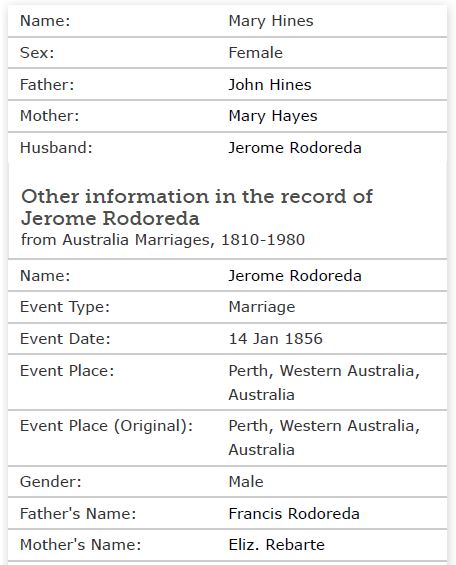
Whatever possessed my newly rediscovered great-great-grandaunt to go to Western Australia? Presumably Mary Anne Hynes was looking for a better life than the one she saw before her in Ireland, but if she fancied Australia, why not go to one of the more established colonies?
At the time, Western Australia was not considered ideal for human settlement. Its sandy soil was completely unsuitable for feeding a population. But that did not deter the British from forming the 'free' Swan River Colony (now Perth) there in 1829, and when the inevitable happened, and labour was in short supply, they started transporting convicts there in 1850. When Mary Anne arrived a few years later, Perth was little more than a penal colony.
Travelling for family reasons?
On 28 December 1853, presumably having just celebrated their last Christmas with family at home, 237 passengers, including Mary Anne, boarded the 'Victory' at Plymouth in England. The ship sailed on a government chartered voyage, bound for Western Australia. Surprisingly, 13 of the passengers shared the surname Hynes or Hines. So initially I thought Mary Anne had gone with family, but after a little research, it doesn't look like any of them were her close relatives.
William Hines, his wife Mary and their five children were Church of England, born in England. Hugh Hynes, his wife Alicia and sister Ellen were seemingly Church of Ireland, born in Dublin, but Hugh and Ellen were the children of a Joseph Hynes. Then there was Catherine and Mary Hynes, both Roman Catholics. They were known to Mary Anne in Perth. Mary was even Godmother to her daughter Christina in 1859. But their parents were George and Catherine Hynes, not my third-great-grandparents John and Margaret.
The usual reasons for single women to go to Western Australia
It seems the British government was keen to assist the passage of young, single women to Perth. They wished to reduce the gender imbalance exasperated by convict transportation and increase the supply of potential wives. The premiss was the women would have a civilising effect on the men, and encourage them to settle down.
The Western Australian authorities apparently also sought young single women, but for a different reason. They were mainly looking for domestic servants to serve the free population. Seemingly, unlike in the other Australian colonies, those in Perth actually preferred the Irish, which may have been just as well. Living conditions in Perth were apparently so awful, they might only appeal to destitute girls from the Irish workhouse system.
It's unlikely Mary Anne was in the workhouse. She had the support of a large family in Dublin. It's also unlikely she travelled all the way to Perth in the hopes of landing a great job as a domestic servant. And I sincerely doubt she had her heart set on marrying an ex-convict. I suspect, she was duped into going to Western Australia.
The Emigration Commission
The Emigration Commission offered suitable candidates free or subsidised passage to Australia, with the government paying a fee per emigrant. Unscrupulous agents might say anything to potential travellers to ensure their participation in the scheme, in order to receive this bounty. And the young women might take them at their word, especially if they were illiterate. Though unproven to my eyes, there is an indication Mary Anne was illiterate, unlike her sister Catherine who could certainly read and write.
So, what if the agents told Mary Anne the Victory was sailing to Melbourne, and she believed them? Or what if they told her, once in Perth, she could easily catch a train to Southern Australia? Irish girls probably had no concept of the distance involved. And, once they landed in Perth, and realised their error, what exactly could they do to hold the agent to account?
This is not all pure conjecture on my part either.
Passengers disembarking from the Victory itself claimed the Emigration Commission had assured them they were going to South Australia!
 |
| The Perth Gazette and Independent Journal of Politics and News, 31 March 1854, p. 2. |
And in a newspaper article written just two weeks later, emigrants, on arrival in Western Australia, were said to have 'expressed great surprise at not being able to take either rail or coach and be at once transported to Melbourne, in a few hours'.
 |
| Inquirer[Perth], 12 April 1854, pp 2-3 |
My guess is, Mary Anne was fooled by the Emigration Commission into going to Perth. Nevertheless, she married, raised a family and lived out the rest of her days in the colony. Some more about that soon.
Sources:
1. Passenger list of the Victory, 1853, in the 'Western Australia, Australia, Crew and Passenger Lists, 1852- 1930', from the State Records Office of Western Australia, Perth, Australia, accessed at $ Ancestry.com.
2. Burial of William and Mary Hines, East Perth Cemeteries.
3. Hynes-Halligan Marriage, 1853, Civil records on IrishGenealogy.ie.
4. Baptism register, Christina Rodoreda, 1859, Church of the Immaculate Conception in Perth, accessed 'Catholic church records of Perth, 1844-1967', Baptisms, 1844-1899, unindexed images, image 88 and 89 of 547, FamilySearch.
5. The Perth Gazette and Independent Journal of Politics and News, 31 March 1854, p. 2, accessed on Trove.
6. Inquirer [Perth], 12 April 1854, pp 2-3, accessed on Trove.
Further articles about Mary Anne (Hynes) Rodoreda:-








